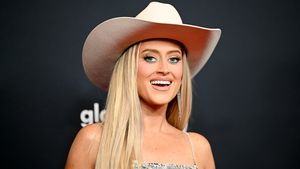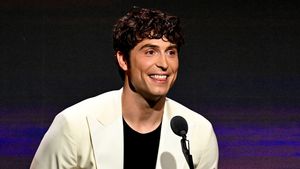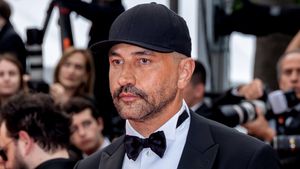Martina Navratilova sat down with The Advocate's Andrew Harmon to talk about her career, coming out, her recent heath scares with cancer and pulmonary edema, and the legal battle resulting from her break-up. Find the full article on Advocate.com, and watch a behind the scenes video interview below.
Here are some excerpts from the interview. Read the full interview on Advocate.
Navratilova has seen better years. She started 2010 with a fractured wrist she sustained while playing hockey — the first time, as it happens, that one of the titans of the professional sports world has ever broken a bone. Then in February, Navratilova was diagnosed with breast cancer. It was noninvasive but required a lumpectomy, followed by radiation therapy. Add to that the reported $3 million settlement of a lawsuit brought by a former partner that had spawned tabloid headlines like “Martina Navratilova Sued for Millions by ‘Wife’ After Being ‘Dumped Without Warning.’” Then bookend those misfortunes with a charity trek up Africa’s tallest peak in December that ended in a high-altitude pulmonary edema scare, an emergency descent, and days of hospitalization.
When I ask how she’s doing, post–cancer treatment, post–Kilimanjaro scare, she answers cheerfully, the same way when people ask about her woodworking pursuits. “Ten fingers!” she says with a smile, holding up both hands. “Ten fingers, 10 toes, and two boobs.” Her prognosis following treatment is excellent. “Less than 5% chance of it coming back,” she says. “I like those odds. If it comes back, I’ll deal with it. If it doesn’t, great. I just had my mammogram last week, and it’s all clear.”
Navratilova is still very much in touch as an activist — someone who more than 18 years ago was a plaintiff in Romer v. Evans, a lawsuit against Colorado’s odious Amendment 2, which denied any antidiscrimination protections to gay, lesbian, and bisexual residents. While on tour in the early 1990s she was highly vocal about her opposition to the measure — at a time when it wasn’t nearly as compulsory for celebrities to have causes, especially controversial ones. Navratilova was insistent. “Wouldn’t you want me on the front lines?” she asked Sports Illustrated in 1992, shortly after the amendment’s passage (in the article the writer implied that Navratilova’s activism was sucking her attention away from the sport). A few years later the U.S. Supreme Court struck down the amendment.
“If Amendment 2 came up again, it would be defeated soundly. Despite what all the lovely people in Colorado Springs are trying to do,” she says of the American evangelical capital. And perhaps she's right. As of press time, the Colorado Senate Judiciary Committee just approved a state civil unions bill.
There are certain characteristics that mark an effective activist. Indefatigability and enduring outrage are among them, and Navratilova has both when she speaks about injustice continually inflicted on gay people. Of the teens who have hanged themselves, overdosed, or jumped off bridges over the past year: “What a price to pay to bring attention to bullying in schools and what it does to kids. Kevin Jennings [cofounder of the Gay, Lesbian, and Straight Education Network and now an assistant deputy secretary at the U.S. Department of Education] has been yelling and screaming about that for years. And now it’s getting the attention it should have had years ago.” Of lawmakers who use homophobia for political advantage: “I just want to strangle these mostly Republicans who just refuse to recognize hate crimes and who equate homosexuality with bestiality and pedophilia. And they get away with it. The way they’re bashing Obama is unbelievable. Why is it OK for them to be bullies?” And of Democrats: “They can’t keep backing down! Stand up. I did not agree with [President George W.] Bush, but he stood up for what he believed in, and he just didn’t back away. Even in the face of facts. Obama, he’s got such a hard sell, but I still think he backs off too much.”
More on next page...
\\\
(continued)
Backing off — not something you can accuse Navratilova of doing in her career, even though she hasn’t always lived her life on her own terms. Thirty years ago, in 1981, she gave a reporter for the New York Daily News an interview that included comments about her personal life and sexual orientation, but ultimately did so with the understanding that the journalist wouldn’t run the story until Navratilova decided herself to go public. Today she recalls that she wanted to come out a few years earlier but was told not to, that it would damage the women’s tour. In 1980 she had been passed over for president of the Women’s Tennis Association players’ union in favor of Chris Evert, mainly the result, she has said, of her sexual orientation, which she was up-front about with the tour’s board of directors. Coming out might mean loss of sponsorship appeal, as happened to Billie Jean King in 1981, when she was outed by her secretary, Marilyn Barnett, who filed a palimony suit against her.
Navratilova also had been working toward obtaining her U.S. citizenship, which she gained in the summer of 1981. “From 1952 to 1990, LGBT people were barred by law from entering the U.S., first as ‘psychopathic personalities’ and later as ‘sexual deviants,’” says Immigration Equality executive director Rachel B. Tiven. “A court decision in 1983 took the teeth out of it, but if Martina had admitted to being gay, she could have been denied entry on that basis.”
At the time of the Daily News interview, Navratilova was dating professional basketball star Nancy Lieberman, who was not out of the closet. After she became a citizen, Navratilova still refused to go on-record, though the newspaper ran her comments anyway, on July 30, 1981. But she never denied her sexuality, she says. “And I’m proud of that.”
Among the harshest accusations leveled by critics is that she’s used anti–gay marriage laws to her advantage in court. “Martina is a gay and lesbian hypocrite. She says she is a big advocate for gay and lesbian rights, but only when it’s convenient,” Ray Rafool, the attorney for Navratilova’s ex-partner Toni Layton, said in 2009.
But how frustrating it must be, the continued obscurity of gay and lesbian historical achievement, for those who refused to hide when it would have been more convenient (and lucrative) to do so. Sure, there’s a paper trail: At any reputable library one can find biographies of Bayard Rustin or Alice B. Toklas, or yes, Navratilova. Any number of websites, professional or homespun, can piece together a world of clandestine bars, brutal police stings, spare poetry left behind by those who have died of AIDS. But you’re still unlikely to learn in an American classroom of eras when coming-out stories of celebrities did not automatically garner a fawning cover profile in People. “I do get pissed off when I’m at some gay event and there’s a 25-year-old and he has no idea who I am,” Navratilova says. “And I say, ‘You need to know more about your gay history, boy.’ I think the younger generation takes it a little bit for granted.”
It’s hard to quibble with that; nor can I fault her desire for accuracy. Though I do wonder whether, looking back on her career and her willingness to be out, she would do anything differently. “Nope. No. Not at all,” Navratilova says with an intense stare. “If anything, I would have been more in-your-face.”
Read the full interview here.
Follow SheWired on Twitter!
Follow SheWired on Facebook!
Be SheWired's Friend on MySpace!




























































































































